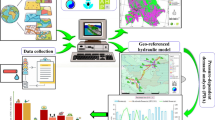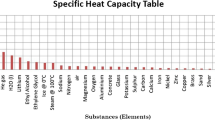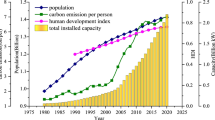Abstract
This paper presents the dynamic simulation of an urban water supply system based on a phenomenological model of distributed parameters capable of predicting the hydraulic behavior and the energy consumption. This case study involves a segment of the supply and distribution water system in the city of Salvador (Brazil), and the analysis focuses on the pumping station, water mainline, and distribution tanks. The current operation of the system is performed through heuristic rules based on expert knowledge, and the control of discharge flow pumps is essentially on/off. The comparison between simulation results and measured data shows that the model describes the hydraulic network satisfactorily as it is able to predict the transient behavior of the flow along the water main line. Considering the high capacity and dimensions together with the intrinsic dynamic features (disturbances caused by the maneuvers in the pump operation and variable demand throughout the day), the use of dynamic modeling for the case studied is really needed for the simulation results to be consistent. Furthermore, the dynamic model and strategy used enables a careful analysis of the water supply system and represents a potential tool for the evaluation of control strategies and energy efficiency. The results show the potential gain in energy efficiency with the inclusion of frequency converters in the pumping system without considerable changes in the level of reservoirs and ensuring the total service demand.












Similar content being viewed by others
References
Abe, D. S., et al. (2005). Carbon gas cycling in these sediments of Serra Da Mesa and Manso reservoirs, Central Brazil. Verhandlungen–Internationale Vereinigungfür Theoretischeund Angewandte Limnologie, 29, 567–572.
Afshar, M. H., & Rohani, M. (2008). Water hammer simulation by implicit method of characteristic. International Journal of Pressure Vessels and Piping, 85(12), 851–859.
Barán, B., Lücken, C. V., & Sotelo, A. (2005). Multi-objective pump scheduling optimization using evolutionary strategies. Journal of Advances in Engineering Software, 36(1), 39–47.
Beckwith, S. F., & Wong, K. P. (1995). A genetic algorithm approach for electric pump scheduling in water supply system. In Proc. of the IEEE Conference on Evolutionary Computation (pp. 21–26). Australia: Perth.
Bird, R. B., Stewart, W. E., & Lightfoot, E. N. (1960). Transport phenomena. New York: Wiley.
Bortoni, E. A., Almeida, R. A., & Viana, A. N. C. (2008). Optimization of parallel variable-speed-driven centrifugal pumps operation. Energy Efficiency, 1(3), 167–173.
Boulos, P. F., et al. (2005). Hydraulic transient guidelines for protecting water distribution systems. Journal of the American Water Works Association, 97(5), 111–124.
Bounds, P., Kahler, J., & Ulanicki, B. (2006). Efficient energy management of a large-scale water supply system. Journal of Civil Engineering and Environmental Systems, 23(3), 209–220.
BRASIL (Ministério de Minas e Energia). (2011). Balanço Energético Nacional – BEN. Brasília: MME.
Brion, L. M., & Mays, L. W. (1991). Methodology for optimal operation of pumping stations in water distribution systems. Journal of Hydraulic Engineering, 117(11), 1551–1569.
Carravetta, A., et al. (2012). Energy production in water distribution networks: a PAT design strategy. Water Resources Management, 26(13), 3947–3959.
Chase, D. V., and Ormsbee, L. E. (1989). Optimal pump operation of water distribution system with multiple storage tanks. In: Proc. Conf. on Water Resour. Plann. Manag., 733–736.
Chaudhry, M. H. (1979). Applied hydraulic transients. New York: Reinhold.
Chen-Shan, L. (2006). An efficient backward group preserving scheme for the backward in time Burger’s equation. Computer Modeling in Engineering and Science, 12, 55–65.
Christoph, T. S., & Waymond, R. S. (2002). On the stability of the FDTD algorithm for elastic media at a material interface. IEEE Transactions on Geoscience and Remote Sensing, 40(2), 474–481.
COELBA (Companhia Elétrica do Estado da Bahia). (2011). Tabela de tarifa e preço final de energia elétrica. Salvador: COELBA.
Coulbeck, B., & Orr, C. H. (1984). Optimized pumping in water supply systems. In Proc. of IFCA, IX Triennial World Congress (pp. 3175–3180). Hungary: Budapest.
Coulbeck, B., et al. (1988). A hierarchical approach to optimized control of water distribution systems: part 1 decomposition. Journal of Optimal Control Applications and Methods, 9(1), 51–61.
Demoyer, R., & Horowitz, L. (1975). A systems approach to water distribution modeling and control. Boston: Lexington.
Ebacher, G., et al. (2011). Transient modeling of a full-scale distribution system: comparison with field data. Journal of Water Resources Planning and Management, 137(2), 173–182.
Fenghua, Z., Zhizhang, C., & Jiazong, Z. (1999). A finite-difference time-domain method without the courant stability conditions. IEEE Microwave and Guided Wave Letters, 9(11), 441–443.
Fleming, K. K., et al. (2006). Susceptibility of distribution systems to negative pressure transients. New York: American Water Works Association.
Gupta, I., & Khanna, G. P. (1999). Genetic algorithm for optimization of water distribution systems. Environmental Modeling and Software, 14(5), 437–446.
Haddad, O., Afshar, A., & Mariño, M. A. (2006). Honey-bees mating optimization (HBMO) algorithm: a new heuristic approach for water resources optimization. Journal of Water Resources Planning and Management, 20(5), 661–680.
IEA (International Energy Agency). (2011). World energy outlook. Paris: OECD/IEA.
Ismaier, A., & Schlücker, E. (2009). Fluid dynamic interaction between water hammer and centrifugal pumps. Nuclear Engineering and Design, 239, 3151–3154.
Izquierdo, J., & Iglesias, P. L. (2002). Mathematical modeling of hydraulic transients in simple systems. Journal of Mathematical and Computer Modeling, 35(7–8), 801–812.
Jowitt, P. W., & Germanopoulos, G. (1992). Optimal pump scheduling in water-supply networks. Journal of Water Resources Planning and Management, 118(4), 406–422.
Kessler, A., & Shamir, U. (1989). Analysis of the linear programming gradient method for optimal design of water supply networks. Journal of Water Resources Research, 25(7), 1469–1480.
Kwon, H. J. (2007). Analysis of transient flow in a piping system. Journal of Civil Engineering, 11(4), 209–214.
Lambeth, J., & Houston, J. (1991). Adjustable frequency drives saves energy. Water & Environmental Technologies, 3(5), 34.
Lansey, K. E., & Awumah, K. (1994). Optimal pump operations considering pump switches. Journal of Water Resources Planning and Management, 120(1), 17–35.
Lansey, K. E., and Zhong, Q. (1990). A methodology for optimal control of pump station. In: Proc. Conf. on Water Resourc. Plann. Manage, 58–61.
Lansey, K. E., et al. (1989). Water distribution system design under uncertainties. Journal of Water Resources Planning and Management, 115(5), 630–645.
LeChevallier, M. W., et al. (2003). The potential for health risks from intrusion of contaminants into the distribution system from pressure transients. Journal of Water and Health, 1, 3–14.
Lingireddy, S., & Wood, D. J. (1998). Improved operation of water distribution systems using variable-speed pumps. Journal of Energy Engineering, ASCE, 124(3), 90–103.
López-Ibáñez, M., Prasad, T. D., & Paechter, B. (2008). Ant colony optimization for optimal control of pumps in water distribution networks. Journal of Water Resources Planning and Management, 134(4), 337–346.
Maier, H. R., et al. (2003). Ant colony optimization for design of water distribution systems. Journal of Water Resources Planning and Management, 129(3), 200–209.
Marques, C. A. X., et al. (2009). Efficiency control in a commercial counter flow wet cooling tower. Journal of Energy Conversion and Management, 50(11), 2843–2855.
Mays, L. W. (2004). Water distribution systems handbook. New York: McGraw-Hill.
Ormsbee, L. E., & Lansey, K. E. (1994). Optimal control of water supply pumping systems. Journal of Water Resources Planning and Management, 120(2), 237–252.
Ormsbee, L. E., et al. (1987). Techniques for improving energy efficiency at water supply pumping stations. Jackson: U.S. Army Engineer Waterways Experiment Station.
Ormsbee, L. E., Walski, T. M., & Sharp, W. W. (1989). Methodology for improving pump operation efficiency. Journal of Water Resources Planning and Management, 115(2), 148–164.
Ozdemir, E. (2003). Energy conservation opportunities with a variable speed controller in a boiler house. Applied Thermal Engineering, 24(7), 981–993.
Pinto, J. C., & Lage, P. L. C. (2001). Mathematical methods in chemical engineering problems. Rio de Janeiro: COPPE/UFRJ.
Quindry, G. E., Brill, E. D., & Liebman, J. C. (1981). Optimization of looped water distribution systems. Journal of Environmental Engineering, 107EE4, 665–679.
Ramos, J. S., & Ramos, H. M. (2010). Multi-criterion optimization of energy management in drinking systems. Water Science and Technology: Water Supply, 10(2), 129–144.
Ramos, H. M., Kenov, K. N., & Vieira, F. (2011). Environmentally friendly hybrid solutions to improve the energy and hydraulic efficiency in water supply systems. Energy for Sustainable Development, 15(4), 436–442.
Reis, L. F. R., et al. (2005). Multi-reservoir operation planning using hybrid genetic algorithm and linear programming: an alternative stochastic approach. Journal of Water Resources Management, 19(6), 831–848.
Sanks, R. L. (1998). Pumping stations—design and construction (2nd ed.). New York: Butterworth-Heinemann.
Schiesser, W. E. (1991). The numerical method of lines: integration of partial differential equations. San Diego: Academic.
Schittkowski, K. (1997). Parameter estimation in one-dimensional time-dependent partial differential equations. Optimization Methods and Software, 7(3–4), 165–210.
Swamee, P. K., & Sharma, A. K. (2008). Design of water supply pipe networks. New Jersey: Wiley.
Tarquin, A. J., & Dowdy, J. (1989). Optimal pump operation in water distribution. Journal of Hydraulic Engineering, 115(2), 158–168.
Ulanicki, B., Kahler, J., & Coulbek, B. (2008). Modeling the efficiency and power characteristics for a pump group. Journal of Water Resources Planning and Management, 134(1), 88–93.
Vieira, F., & Ramos, H. M. (2008). Hybrid solution and pump-storage optimization in water supply system efficiency: a case study. Energy Policy, 36(1), 4142–4148.
Vieira, F., & Ramos, H. M. (2009). Optimization of the energy management in water supply systems. Water Science and Technology: Water Supply, 9(1), 59–65.
Viholainen, J., et al. (2012). Energy-efficient control strategy for variable speed-driven parallel pumping systems. Energy Efficiency, 6(3), 495–509.
Vilela, O. C., & Fraidenraich, N. (2001). A methodology for the design of photovoltaic water supply systems. Progress in Photovoltaics: Research and Applications, 9(5), 349–361.
Walski, T. M. (1984). Analysis of water distribution systems. New York: Van Nostrand Reinhold.
Wanakule, N., Mays, L. W., & Lasdon, L. S. (1986). Optimal management of large-scale aquifers: methodology and applications. Journal of Water Resources Research, 22(4), 447–465.
Wang, H., & Guo, W. (2010). ACO optimizing neural network for macroscopic water distribution system modeling. In Proc. International Conf. on Intelligent Computing and Cognitive Informatics (pp. 367–370). USA: Washington.
Wood, D. J., et al. (2005). Numerical methods for modeling transient flow in distribution systems. Journal of the American Water Works Association, 97(7), 104–115.
Worthington. (1988). Catálogo de bombas. Rio de Janeiro: Worthington do Brasil.
Wylie, E. B., & Streeter, V. L. (1978). Fluid transients. New York: McGraw-Hill.
Yu, G., Powell, R. S., & Sterling, M. J. H. (1994). Optimized pump scheduling in water distribution systems. Journal of Optimization Theory and Application, 83(3), 463–488.
Zessler, U., & Shamir, U. (1989). Optimal operation of water distribution systems. Journal of Water Resources Planning and Management, 115(6), 735–752.
Author information
Authors and Affiliations
Corresponding author
Appendix—Equation of motion from equation of thermal energy
Appendix—Equation of motion from equation of thermal energy
From the complete equation of energy that considers the rate of accumulation of internal and kinetic energy, it is possible to derive the equation of thermal energy (by analogy with the equation of mechanical energy) that only considers the rate of gain of internal energy (Bird et al. 1960). Then, for an infinitesimal element of fluid in one-dimensional flow, the following equation is valid:
u is the internal energy per unit mass of fluid in the element (control volume), v is the local fluid velocity, p is the static pressure, τ is the stress tensor and q is the heat flux vector. Du/Dt is the substantial derivative (derivative following the fluid motion) of u. − (∇ ⋅ q) represents the rate of internal energy input by conduction (per unit volume), − p ⋅ (∇ ⋅ v) and − (τ : ∇v) represents reversible rate of internal energy increase by compression and irreversible rate of internal energy increase by viscous dissipation (friction loss), respectively, both per unit volume. Assuming incompressible flow, (∇ ⋅ v) = 0, and integrating Eq. A.1 over the control volume:
Applying the Leibnitz formula for differentiating integral and equation of continuity,
where dU/dt is the total time derivative, and U is the total internal energy in the system. An unsteady-state macroscopic energy balance, assuming no shaft work and that the time derivative of total potential energy is negligible, leads to Eq. A.4:
z is the quota, w is the mass rate of flow, 〈v〉 is the average velocity over conduit cross-section, Q is the net rate of heat added to the system, and K is the total kinetic energy in the system.
Using the Gauss divergence theorem:
Using Eqs. A.3, A.4, and A.5 in Eq. A.2:
Using Eq. 2 and expressing \( K={\displaystyle \underset{V}{\int}\frac{1}{2}\rho {v}^2 dV}\kern1em \mathrm{and}\kern0.75em {\displaystyle \underset{V}{\int}\left(\tau :\nabla v\right) dV}={\displaystyle \underset{V}{\int}\rho {\hat{E}}_v dV} \), where\( {\widehat{E}}_v \) denotes the friction loss per unit of mass rate flow:
For incompressible and isothermal flow, Δu = 0. The other net rate added can be expressed as volume integrals:
Replacing in Eq. A.7:
For an incompressible and one-dimensional flow, Eq. A.9 provides the following equation:
v x is the component of velocity in the x-direction.
The Eq. 6 is derived directly from Eq. A.10 considering that the term v x ⋅ ∂v x /∂x is significantly smaller than the term ∂v x /∂t (Chaudhry 1979), using Darcy-Weisbach formula to compute the friction loss and writing Eq. A.10 in terms of volumetric flow (Q).
Rights and permissions
About this article
Cite this article
Diniz, A.M.F., Fontes, C.H., Da Costa, C.A. et al. Dynamic modeling and simulation of a water supply system with applications for improving energy efficiency. Energy Efficiency 8, 417–432 (2015). https://doi.org/10.1007/s12053-014-9292-4
Received:
Accepted:
Published:
Issue Date:
DOI: https://doi.org/10.1007/s12053-014-9292-4




